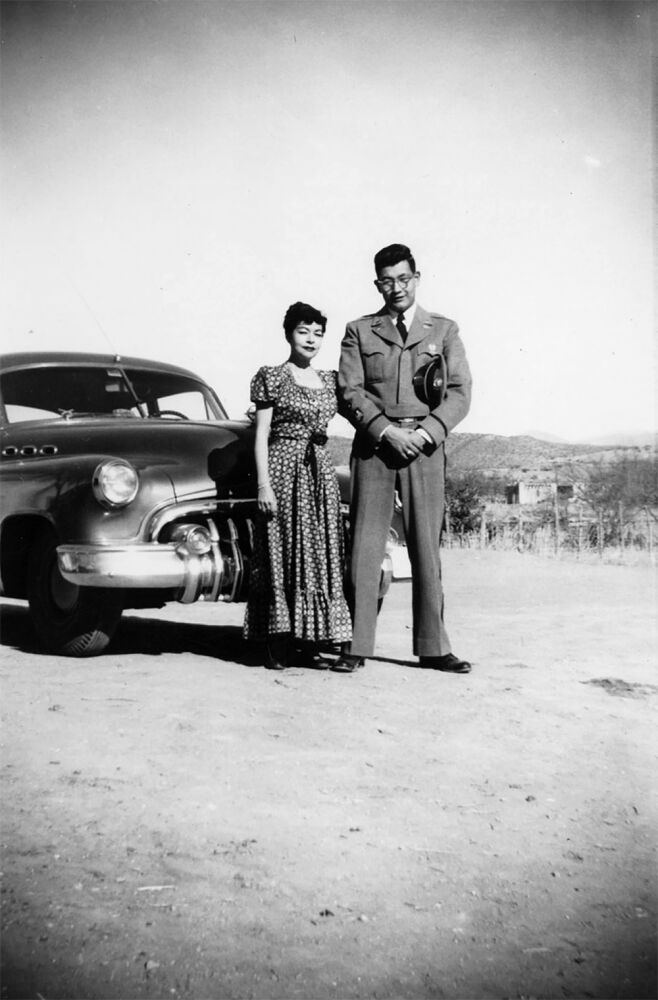Issue 242, Winter 2022
 Momaday in his cadet uniform, with his mother, Natachee, in Jemez Pueblo, ca. 1952. Courtesy of N. Scott Momaday.
Momaday in his cadet uniform, with his mother, Natachee, in Jemez Pueblo, ca. 1952. Courtesy of N. Scott Momaday.
Driving from Santa Fe’s center to its outskirts, you pass through a wide expanse made vibrant by that particular slant of light Georgia O’Keeffe coveted. Somehow, the sky is more immense here. Hawks circle over dusty fields strewn with yellow-flowering rabbitbrush. Beyond this plain is the quiet suburb where N. Scott Momaday lives, in a square adobe house. The walls of the living room are lined with prints of Native Americans by Leonard Baskin, which Momaday, a painter and printmaker himself, has collected for decades. On the coffee table sits a bronze sculpture of the Wyoming rock formation known as Devils Tower, with a bear at its base; as an infant, Momaday was taken to this sacred site and given his Kiowa name, Tsoai-talee, or “Rock-Tree Boy,” after the story of a boy who turned into a bear, chasing his sisters up the “rock-tree” and into the stars.
N. Scott Momaday was born in 1934 in Lawton, Oklahoma. During the Depression, his parents, Alfred Morris and Mayme “Natachee” Scott Momaday, found work on the Navajo reservation in New Mexico, and, during the war, in Hobbs, around the nearby military base. In 1946, the family moved to another Native community, Jemez Pueblo, where for many years his father taught painting and his mother English. At seventeen, Momaday attended military school in Virginia for a year, and he then enrolled at the University of New Mexico, where he met his first wife, Gaye Mangold, the mother of three of his four daughters. He entered Stanford University’s fellowship program in writing, which led to a doctorate and a series of posts at schools including Stanford, the University of California at Berkeley, and the University of Arizona, where for many years he taught poetry and a class on the oral tradition.
Before Momaday began to publish, there was little widespread consciousness of a Native American literature. House Made of Dawn, his first novel, appeared in 1968, and won the Pulitzer Prize. The story of a traumatized Second World War veteran who struggles to resume his life on the pueblo, it shrewdly combines Modernist techniques and Native traditions. Momaday’s exploration of genre continued in The Way to Rainy Mountain (1969), a hybrid of Kiowa folklore, historical commentary, and memoir; The Names (1976), a family history that glides through streams of consciousness; and his second novel, The Ancient Child (1989), a swirl of fragments that features Billy the Kid, abstract painting, and “bear medicine.”
But Momaday thinks of himself first as a poet, and his early collections Angle of Geese (1974) and The Gourd Dancer (1976)demonstrate a restless sensibility, the poems moving between metrical verse and incantatory repetition, landscape and legend. He frequently includes his older poems in new collections, encompassing them, like the rings of a tree, in fresh material. Since retiring from professorship, Momaday has become only more productive, publishing three books in the past three years. The Death of Sitting Bear (2020) contains some of his most complex poetry, and is characterized by a wintry, Stevensian reserve. Earth Keeper (2020), a taut book of prose poems, urges a greater stewardship of the environment.
Momaday is a big man with a wry sense of humor, his large frame matching his deep and sonorous voice. In the conversations for this interview, which Layli Long Soldier began on the phone in 2021 and which I continued over several clear-skied afternoons earlier this year, he was gregarious and generous, though he felt no need to answer a question he considered inapt. His daughters Jill and Brit sometimes sat in—Jill taking pleasure in pushing him to clarify his version of events—and Quanah, a tabby cat named after a famous peyote priest, occasionally jumped up to demand his affection. Momaday was as willing to perform the stories he has told many times as he was to consider them anew. This continual redescription of his experience, in person and on the page, seems to reflect a lasting passion for being on earth. As he writes in “The Delight Song of Tsoai-talee,”
I am an angle of geese in the winter sky
I am the hunger of a young wolf
I am the whole dream of these things
You see, I am alive, I am alive
—David S. Wallace



